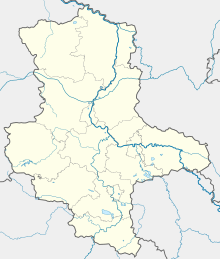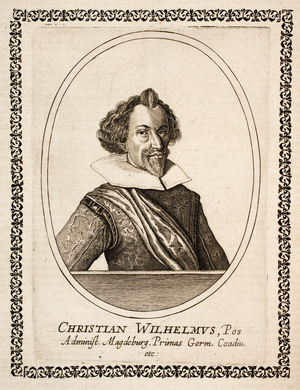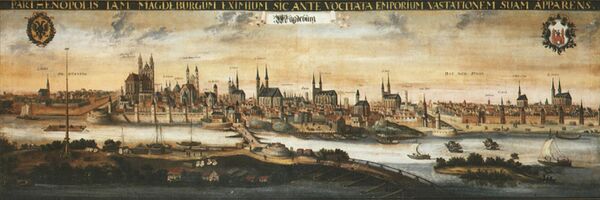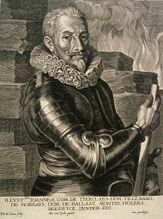نهب ماغديبورغ
| نهب ماگدبورگ | |||||||
|---|---|---|---|---|---|---|---|
| جزء من حرب الثلاثين عام | |||||||
 حفر يصور نهب ماگدبورگ، من صنع ماتويس مريان | |||||||
| |||||||
| المتحاربون | |||||||
|
|
| ||||||
| القادة والزعماء | |||||||
|
|
| ||||||
| القوى | |||||||
| 24,000 | |||||||
| الضحايا والخسائر | |||||||
|
300 قتيل 1,600 جريح[1] | 20,000 ساكن[1] | ||||||
الموقع داخل Saxony-Anhalt | |||||||
نهب ماگدبورگ (بالألمانية: Magdeburger Hochzeit) حلقة من المرحلة السويدية لحرب الأعوام الثلاثين، ويشير إلى الحصار وما أعقبه من اجتياح لمدينة ماگدبورگ الألمانية، بدأ الحصار في نوفمبر من عام 1630 ، و اقتحمت المدينة في 20 مايو 1631.
بنزول السويديين جزيرة أوزيدوم في بوميرانيا في السادس من يونيو سنة 1630، وما ترتب عليه من اندلاع للقتال بين السويد و الإمبراطورية الرومانية المقدسة، وجدت مدينة ماگدبورگ وهي الحليف السويدي الوحيد في ألمانيا نفسها في وضع صعب. مثلت المدينة بإمداداتها قاعدة مثالية للسويديين من أجل السيطرة على منطقة نهر إلبه، لهذا السبب اتجهت قوات الرابطة الكاثوليكية نحو المدينة، وباشرت الحصار تحت قيادة گوتفريد هاينريش، كونت بابنهايم.
في مايو سنة 1631 وصل يوهان تسركليه، كونت تيلي بتعزيزات كاثوليكية، سمحت بالهجوم على المدينة في 20 من ذات الشهر. نجح الهجوم أيضاً بفضل بعض المكاسب على حساب دفاعات الخصم في الأيام السابقة، ودخلت حوالي 40،000 مقاتل كاثوليكي المدينة؛ بيد أنهم فقدوا في تلك اللحظة كل سيطرة على أنفسهم، واقترفوا عمليات قتل ونهب وتخريب عنيفة، يقدر بأن 25،000 نفساً قد ازهقت خلالها من أصل 30،000 هم سكان المدينة.
أسباب النهب وما حصل سواءً اعتمدت أم لا، ما تزال أمراً قيد المناقشة، ولكن بعض الاعتبارات جعلت غالبية المؤرخين تميل للرأي القائل إن هذا الحدث لم يكن تنفيذاً لأوامر ، ولكنه نشأ من غضب القوات الكاثوليكية العارم . قد يؤيد هذه الرواية للأحداث تقديم تيلي اقتراحاً بالاستسلام إلى المدينة قبل بضعة أيام من الهجوم ، والذي قد يشير إلى نية القائد الكاثوليكي لاستغلال المدينة كقاعدة عمليات له، بالإضافة إلى أن وجود قائد خبير مثل تيلي كان من الصعب أن تخلو من العيوب سواءاً السياسية أو العسكرية، والتي أسفرت عن تدمير ماگدبورگ.
كان لعمليات السلب والنهب عواقب سياسية كبرى: اقتناع دولتي ساكسونيا وبراندنبورگ المترددتين بالانضمام إلى حالة السويدية في نهاية المطاف وسهلت الغزو السويدي لألمانيا؛ كانت سيطرة الكاثوليك على قاعدة محصنة في وادي إلبه يمكن أن تمثل عقبة خطيرة على قوات البروتستانتية.
. . . . . . . . . . . . . . . . . . . . . . . . . . . . . . . . . . . . . . . . . . . . . . . . . . . . . . . . . . . . . . . . . . . . . . . . . . . . . . . . . . . . . . . . . . . . . . . . . . . . . . . . . . . . . . . . . . . . . . . . . . . . . . . . . . . . . . . . . . . . . . . . . . . . . . . . . . . . . . . . . . . . . . . .
خلفية
مطرانية ماگدبورگ
The archbishopric of Magdeburg was established as an ecclesiastical principality in 968.[2] In political respect the Erzstift, the archiepiscopal and capitular temporalities, had gained imperial immediacy as prince-archbishopric in 1180.[بحاجة لمصدر] This meant that the archbishop of Magdeburg ruled the town and the lands around it in all matters, worldly and spiritual.
الإصلاح الپروتستانتي
The citizens of Magdeburg had turned Protestant in 1524[3] and joined the Schmalkaldic League against the religious policies of the Catholic emperor Charles V in 1531.[4] During the Schmalkaldic War of 1546/47, the Lower Saxon city became a refuge for Protestant scholars, which earned it the epithet Herrgotts Kanzlei (ألمانية for 'Lord's Chancellery'),[5] but also an Imperial ban that lasted until 1562.[6] The citizens refused to acknowledge Emperor Charles's Augsburg Interim and were besieged by Imperial troops under Maurice, Elector of Saxony in 1550/51.[7]
المطارنة والإداريون الپروتستانت
The Roman Catholic archdiocese had de facto turned void since 1557, when the last papally confirmed prince-archbishop, the Lutheran Sigismund of Brandenburg, came of age and ascended to the see.[2][8]
Openly Lutheran Christian William of Brandenburg, elected to be archbishop in 1598, was denied recognition by the imperial authorities.[9] Since about 1600, he styled himself Administrator of Magdeburg, as did other Protestant German notables assigned to govern principalities that were de jure property of the Catholic church.[بحاجة لمصدر]
التحالف مع الملك الدنماركي
During the Thirty Years' War, Administrator Christian William entered into an alliance with Denmark.[9] In 1626, he led an army from Lower Saxony into the Battle of Dessau Bridge. After Wallenstein won this battle, Christian William fled abroad.[10] In 1629, he fled to the court of King Gustavus Adolphus of Sweden.[9]
As a result of these developments, in January 1628, the Magdeburg cathedral chapter deposed Christian William and elected Augustus of Wettin, 13-year-old son of John George I, Elector of Saxony, as Administrator. Augustus did not assume office immediately due to his father's unwillingness to provoke the emperor.[11]
Edict of Restitution
In March 1629, Emperor Ferdinand II passed the Edict of Restitution. It was specifically aimed at restoring the situation of the 1555 Peace of Augsburg in ecclesiastical territories that had since strayed from "legal" Catholic faith and rule.[12] Bremen and Magdeburg were the biggest examples of territories to be restituted.
التحالف مع الملك السويدي
The city's councillors had been emboldened by King Gustavus Adolphus's landing in Pomerania on 6 July 1630.[13] The Swedish king was a Lutheran Christian, and many of Magdeburg's residents were convinced that he would aid them in their struggle against the Roman Catholic Habsburg emperor, Ferdinand II. However, not all Protestant princes of the Holy Roman Empire had immediately embraced Adolphus;[14] some believed his chief motive for entering the war was to take northern German ports, which would allow him to control commerce in the Baltic Sea.[13][15]
In November 1630, King Gustavus sent ex-Administrator Christian William back to Magdeburg, along with Dietrich von Falkenberg to direct the city's military affairs. Backed by the Lutheran clergy, Falkenberg had the suburbs fortified and additional troops recruited.[10]
حصار ماجدبورج
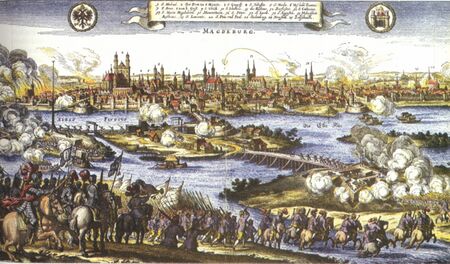
When the Magdeburg citizens refused to pay a tribute demanded by the emperor, Imperial forces under the command of a Flemish mercenary, Johann Tserclaes, Count of Tilly laid siege to the city within a matter of months.[14] The city was besieged from 20 March 1631 and Tilly put his subordinate Imperial Field Marshal Gottfried Heinrich Graf zu Pappenheim, a Catholic convert, in command while he campaigned elsewhere. During fierce fighting, Imperial troops numbering 24,000, roughly the same number as Magdeburg's entire population, conquered several sconces of the city's fortification and Tilly demanded capitulation.[16]
الهجوم والنهب
After two months of siege and despite the Swedish victory in the Battle of Frankfurt an der Oder on 13 April 1631, Pappenheim finally persuaded Tilly, who had brought reinforcements, to storm the city on 20 May with 40,000 men under the personal command of Pappenheim. The Magdeburg citizens had hoped in vain for a Swedish relief attack. On the last day of the siege, the councillors decided it was time to sue for peace, but word of their decision did not reach Tilly in time.
In the early morning of 20 May, the attack began with heavy artillery fire. Soon afterward, Pappenheim and Tilly launched infantry attacks. The fortifications were breached and Imperial forces were able to overpower the defenders to open the Kröcken Gate, which allowed the entire army to enter the city to plunder it. The defence of the city was further weakened and demoralised when commander Dietrich von Falkenberg was shot dead by Catholic Imperial troops.[14]
. . . . . . . . . . . . . . . . . . . . . . . . . . . . . . . . . . . . . . . . . . . . . . . . . . . . . . . . . . . . . . . . . . . . . . . . . . . . . . . . . . . . . . . . . . . . . . . . . . . . . . . . . . . . . . . . . . . . . . . . . . . . . . . . . . . . . . . . . . . . . . . . . . . . . . . . . . . . . . . . . . . . . . . .
النهب والحرق
There are written reports of the attackers setting fire to single houses to dislodge persistent defenders. That the fire then spread all over the city appears to have been unintended. By ten o'clock most of the city was on fire. General Tilly sent some soldiers to save the cathedral, where 1,000 survivors had fled. Most of the victims in the sack suffocated or burned to death. The wind fanned the flames, further spreading the fire, in the end destroying 1,700 of the city's 1,900 buildings.[17]
الخروج عن السيطرة
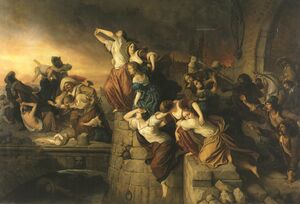
Whilst Magdeburg was razed by the fire, many Imperial soldiers supposedly went out of control. The invading soldiers had not received payment for their service and demanded valuables from every household they encountered. There were reports of rapes[17] and torture.[14]
When civilians ran out of things to give the soldiers, the misery really began.
For then the soldiers began to beat, frighten and threaten to shoot, skewer, hang, etc., the people.— أوتو فون گريكه، عضو مجلس ماگدبورگ[14]
Of the 25,000 inhabitants, only 5,000 survived, at least 1,000 of these having fled into Magdeburg Cathedral and 600 into the Premonstratensian monastery.[17] Tilly finally ordered an end to the looting on 24 May, and a Catholic mass was celebrated at the cathedral في اليوم التالي. لأربعة عشر يوماً إضافيين، كانت الجثث المحترقة تُرمى في نهر إلبه لمنع المرض.
الأعقاب
A census conducted in 1632 listed only 449 inhabitants. Much of the city remained rubble until at least 1720.[17]
ردود الأفعال
I believe that over twenty thousand souls were lost. It is certain that no more terrible work and divine punishment has been seen since the destruction of Jerusalem.[أ] All of our soldiers became rich. God with us.
— Graf Pappenheim، in a letter[18]
After Magdeburg's capitulation to the Imperial forces, there were disputes between residents who had favoured resistance to the emperor and those who had opposed it. King Gustavus Adolphus joined the argument, claiming the citizens of Magdeburg had not been willing to pay the necessary funds for their defence.[14]
Duke Maximilian of Bavaria, president of the Catholic League, concluded a congratulatory letter to Tilly on 1 June with the wish that "the enemies, powers and forces opposing Catholicism, the only religion offering salvation, would finally be ruined".[ب][19]
Pope Urban VIII wrote a congratulatory letter to Tilly on 18 June, saying: "You have washed your victorious hands in the blood of sinners."[ت][20]
The Imperial treatment of defeated Magdeburg helped persuade many Protestant rulers in the Holy Roman Empire to stand against the Roman Catholic emperor.[14]
السمعة السيئة
The devastations were so great that Magdeburgisieren (or "magdeburgization") became a common term signifying total destruction, rape and pillaging for decades. The terms "Magdeburg justice", "Magdeburg mercy" and "Magdeburg quarter" also arose as a result of the sack, used originally by Protestants when executing Roman Catholics who begged for quarter.[21]
The massacre was forcefully described by Friedrich Schiller in his 1792 work History of the Thirty Years' War[22] and perpetuated in a poem by Goethe.[23] A scene of Brecht's play Mother Courage and Her Children, written in 1939, also refers to the event.[24]
العواقب السياسية
Administrator Christian William of Brandenburg was badly injured and taken prisoner. He later converted to Catholicism and was released. He received an annual sum of 12,000 thaler from the revenues of the Archbishopric of Magdeburg under the Peace of Prague.
After the sack, the Archbishopric of Magdeburg went to Archduke Leopold Wilhelm of Austria, youngest son of Emperor Ferdinand II, as the new Catholic administrator. The Peace of Prague (1635) confirmed his rule over the city, but three years later, Swedish troops expelled the Habsburg army and restored Augustus of Wettin (first elected in 1628) as Administrator as of October 1638. Augustus finally took full control of Magdeburg in December 1642 after a neutrality treaty was concluded with the Swedish general Lennart Torstenson. He was then able to begin the reconstruction of the city.
The Archbishopric of Magdeburg was secularized and ultimately fell to Brandenburg-Prussia upon Augustus' death in 1680.
انظر أيضاً
ملاحظات توضيحية
- ^ It is unclear which historical event Pappenheim is referring to here, exactly. Two possible candidates are the violent conquests by the Romans in 70 CE and by the first crusader army in 1099.
- ^ Original German quote: "vnd der Catholisch: alleinseeligmachenden Religion widersezender feinde, macht, gwalt, endtlich ruinirt"
- ^ Original Latin quote: "Potuisti lavare victrices manus in sanguine peccatorum." This paraphrases Psalm 58,10 (KJV) (Psalm 57 in the Latin Vulgate).
الهامش
- ^ أ ب Peter H. Wilson. The Thirty Years War: Europe's Tragedy. Cambridge, Massachusetts: Harvard University Press, 2009. p. 471.
- ^ أ ب Herbermann, Charles, ed. (1910). . Catholic Encyclopedia. Vol. 9. New York: Robert Appleton Company.
- ^ Rein, Nathan (2008). The Chancery of God - Protestant Print, Polemic and Propaganda against the Empire, Magdeburg 1546-1551 (in الإنجليزية). London: Routledge. p. 14. ISBN 9781315240800.
- ^ Pavlac, Brian A.; Lott, Elizabeth S. (2019). The Holy Roman Empire: A Historical Encyclopedia (in الإنجليزية). Vol. 1. ABC-CLIO. p. 252. ISBN 978-1440848568.
- ^ Olson, Oliver K. (1972). "Theology of Revolution: Magdeburg, 1550-1551". The Sixteenth Century Journal. 3 (1): 70. doi:10.2307/2539904. ISSN 0361-0160. JSTOR 2539904.
- ^ Born, Jakob H. (1742). Abhandlung von dem Stapel-Rechte der alten Stadt Magdeburg: worinnen zugleich einige Beweise desselben geprüfet, und die Befugniße der Stadt Leipzig in Ansehung der Stapel-Gerechtigkeit erörtert werden [Treatise on the staple rights of the old city of Magdeburg: wherein some evidence of the same is examined and the powers of the city of Leipzig in view of staple rights are discussed] (in الألمانية). Leipzig: Langenheim. p. 10.
- ^ Issleib, S (1884). "Magdeburgs Belagerung durch Moritz von Sachsen 1550-1551" [The Siege of Magdeburg at the hands of Maurice of Saxony 1550-1551]. Neues Archiv für Sächsische Geschichte (in الألمانية). 5: 177–226.
- ^ Cante, Andreas (1995). "Die Grabanlage Erzbischof Friedrichs IV. von Magdeburg († 1552) im Halberstädter Dom" [The burial site of Archbishop Friedrich IV of Magdeburg (d. 1552) in Halberstadt Cathedral]. Zeitschrift für Kunstgeschichte (in الألمانية). 58 (4): 504–525. doi:10.2307/1482808. ISSN 0044-2992. JSTOR 1482808.
- ^ أ ب ت Berent Schwineköper: Christian Wilhelm. In: Neue Deutsche Biographie (NDB). Bd. 3, Berlin قالب:NDB/Jahr, S. 226.
- ^ أ ب Allgemeine Deutsche Biographie [General German Biography] (in الألمانية). Vol. 4. Munich/Leipzig: Duncker & Humblot. 1876.
- ^ Allgemeine Deutsche Biographie [General German Biography] (in الألمانية). Vol. 1. Duncker & Humblot. 1875. pp. 680–681.
- ^ Osiander, Andreas (2001). "Sovereignty, International Relations, and the Westphalian Myth". International Organization. 55 (2): 256–257. doi:10.1162/00208180151140577. ISSN 0020-8183. JSTOR 3078632. S2CID 145407931.
- ^ أ ب Wilson 2004.
- ^ أ ب ت ث ج ح خ Helfferich 2009.
- ^ Frusetta 2013.
- ^ Tucker, Spencer C. (2021). Great Sieges in World History: From Ancient Times to the 21st Century (in الإنجليزية). Denver: ABC-CLIO. p. 82. ISBN 978-1440868030.
- ^ أ ب ت ث Wilson 2011.
- ^ Medick & Selwyn 2001.
- ^ Meumann & Niefanger 1997.
- ^ von Pastor 1928.
- ^ Nolan 2006.
- ^ Schiller 1792.
- ^ Goethe 1801.
- ^ Brecht 1939.
. . . . . . . . . . . . . . . . . . . . . . . . . . . . . . . . . . . . . . . . . . . . . . . . . . . . . . . . . . . . . . . . . . . . . . . . . . . . . . . . . . . . . . . . . . . . . . . . . . . . . . . . . . . . . . . . . . . . . . . . . . . . . . . . . . . . . . . . . . . . . . . . . . . . . . . . . . . . . . . . . . . . . . . .
للاستزادة
- Brzezinski, Richard (1991). The Army of Gustavus Adolphus. Men-at-Arms series. Vol. 1: Infantry. London: Osprey. ISBN 9780850459975.
- Coupe, W. A. (1962). "Political and Religious Cartoons of the Thirty Years' War". Journal of the Warburg and Courtauld Institutes. Warburg Institute. 25 (1/2): 65–86. doi:10.2307/750542. JSTOR 750542. S2CID 158512299.
- Firoozi, Edith; Klein, Ira N. (1966). Universal History of the World: The Age of Great Kings. Vol. 9. New York: Golden Press. pp. 738–739. OCLC 671293025.
- Ingrao, Charles W. (2000). The Habsburg Monarchy 1618–1815 (2nd ed.). New York: Cambridge University Press. ISBN 9780521780346.
- Paas, John Roger (1996). "The Changing Image of Gustavus Adolphus on German Broadsheets, 1630–3". Journal of the Warburg and Courtauld Institutes. Warburg Institute. 59: 205–244. doi:10.2307/751404. JSTOR 751404. S2CID 195018897.
- Parker, Geoffrey (1997). "The 'Military Revolution,' 1560–1660 – a Myth?". Journal of Modern History. University of Chicago Press. 48 (2): 195–214. JSTOR 1879826.
وصلات خارجية
- Sack of Magdeburg (Archived 13 يونيو 2010 at the Wayback Machine) on Filbrun
- Count of Tilly on History of War
- Pages using gadget WikiMiniAtlas
- Articles incorporating a citation from the 1913 Catholic Encyclopedia with Wikisource reference
- CS1 الألمانية-language sources (de)
- Short description is different from Wikidata
- Coordinates on Wikidata
- Articles with hatnote templates targeting a nonexistent page
- Articles with unsourced statements from July 2022
- Articles containing ألمانية-language text
- Pages using multiple image with auto scaled images
- Germany articles missing geocoordinate data
- All articles needing coordinates
- 1631 في اوروبا
- نزاعات 1631
- حرب الثلاثين عاما
- معارك الامبراطورية الرومانية المقدسة
- ماگدبورگ
- مذابح في ماگدبورگ
- حصارات الامبراطورية الرومانية المقدسة
- تاريخ ساكسونيا-أنهالت
- تاريخ ألمانيا
